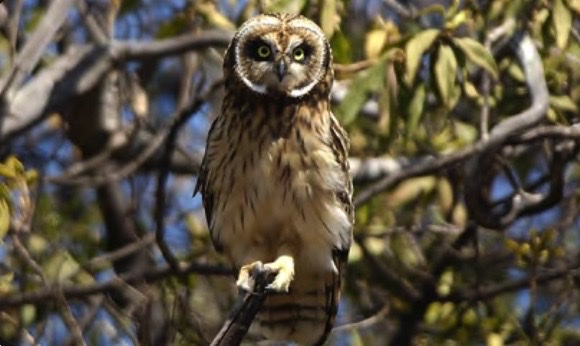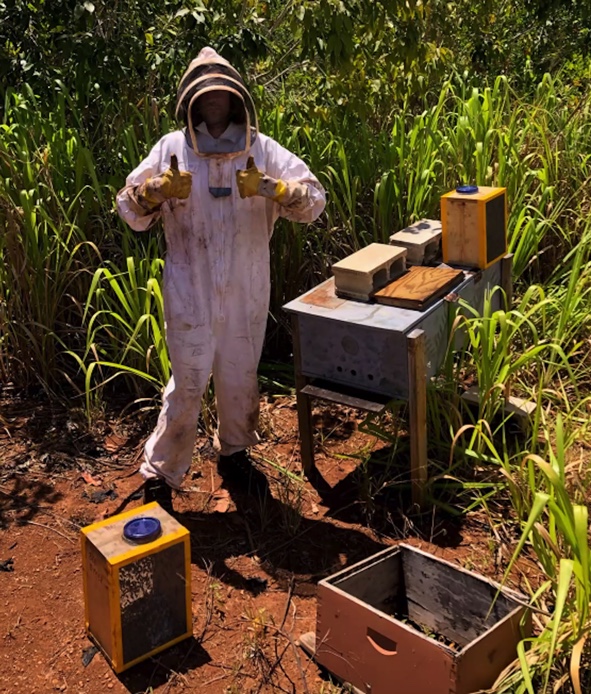The theme of this year’s annual Hawaiʻi Conservation Conference, held July 18 to 22 via Zoom, was “Pilina Mauli Ola — Connections that Offer Resilience and Hope.” So along with presentations reporting the latest results of various natural resource studies and management efforts, sessions explored the traditional and current connections between native Hawaiians and native species, as well as the ways partnerships and collaboration can build a strong conservation community.
The Hawaiʻi Conservation Alliance’s conference website explained, “In Hawaiʻi, pilina or connections with place and with the living elements of the world around us, are the foundations of mauli ola, our mutual well-being. For Kanaka ʻŌiwi (Hawaiians), the connections are ancestral, and for all of us in conservation, the aloha we form in the places we work are the basis for both our own dedication as well as the partnerships we build to address the challenges we face. … We will share stories of success and hope to inspire pilina between people, communities, and place that lead to the innovations needed to address the challenges of conservation in a world undergoing unprecedented transformations.”
The first installment in our coverage of the conference presentations focuses on birds:
‘The Man Standing At the Forest Border’

The presentation by Kaleiheana-a-Pōhaku Stormcrow, a graduate student with the University of Hawaiʻi Wildlife Ecology Lab, stood out among the talks included in the session on seabirds and raptors. Others discussed how bird movements were tracked with radar or tags or described how their presence affects soil nutrients.
Stormcrow’s work showed the abundance of information about pueo, the Hawaiian short-eared owl, that already exists in old Hawaiian language newspapers.
They searched the Papakilo Database, which includes a database of native Hawaiian language newspapers of the 19th century, and identified 1,268 articles related to pueo.
In searching just the terms “manu pueo” and “pueo aumakua,” Stormcrow unearthed and translated references to its appearance, the sounds it makes, its behaviors, its habitat, its diet, the cultural relationships the people had with it, and more. For the aumakua articles, Ralph Lalepa Koga from the University of Hawaiʻi’s Hawaiʻinuiākea (School of Hawaiian Knowledge) assisted with palapala (adding ʻokina & kāhako). Stormcrow added that their mentor, Kawika Winter, also helped with translation, “as needed.”
Indigenous knowledge of nature is coded in cosmology and cultural practices, they explained. However, they added, it has been dismissed by conventional scientists, despite being “a parallel and equal line of inquiry.”
The elusive pueo, their abstract notes, is challenging to study. No population assessment or significant survey efforts have ever been done. The bird is considered endangered on Oʻahu and was included last year in the U.S. Fish and Wildlife Service’s list of birds of conservation concern.
Despite the limited information about pueo, its historical relationship with native Hawaiians has meant that it’s often referred to in kaʻao (legends), moʻolelo (histories), and ʻōlelo noʻeau (proverbial sayings), their abstract states.
“We can use this indigenous knowledge to fill some data gaps pertinent to life history and historical distribution and habitats of pueo and to co-develop new knowledge as we build bridges between indigenous science and conventional science,” it continues.
The newspapers, printed between 1834 and 1948, are the largest archive of printed indigenous knowledge in the world, and are being used to resurrect biocultural knowledge and improve natural resource management, they said.
The newspapers describe the pueo’s large staring (nunui ʻāʻā) eyes, hidden ears, strong pointed beak, long claws, broad wings, and size (“big as a mother hen”).
Its song is described as like a whisper; its alarm call, a woman’s wail; and there’s a reference to the sound of pounding kapa, which they suggested refers to the wing claps pueo make during mating rituals.
According to mele, the pueo is the second born child of Hina (the moon) and the god Kū, and is the younger sibling of Māui, who according to legend pulled the Hawaiian Islands from the sea with a fish hook.
“Because of that, [pueo] would have a pilina or relationship to the sea,” they said. And, in fact, their archives search found a list of animals associated with the sea and the pueo was included.
They added that they also found references to pueo at ponds or springs, open plains, dryland agricultural areas, remote and cloud forests, loʻi kalo, and streams.
Pueo are thought to live on all of the main Hawaiian islands. Stormcrow found 61 place names associated with pueo throughout the state: 21 on Hawaiʻi island, 14 on Maui, 14 on Oʻahu, 5 on Kauaʻi, two on Lanaʻi, two on Molokaʻi, and one on Niʻihau.
In addition to pueo being the younger sibling of Māui, which connects it to the sea, it is also considered to be the kinolau or physical manifestation of the god Kāne. Stormcrow found references to pueo being called Kānekupahuʻa or Kāneikapahuʻa, which translates to “the man standing at the forest border.”
“It’s interesting when you think about edge habitat and how there’s a higher abundance of prey species. … I think that there’s a ton of evidence indicating that [pueo] do hang out in those places a lot,” they said.
Finally, with regard to habitat, they pointed to a rediscovered ʻōlelo noeʻau from an 1896 newspaper: “We have no place to refute you, Pueo, for you are the child born of this place and you know the lay of the land in this entire region as a man knows the berms of his taro field.”
This saying indicates that the pueo perhaps had the largest home range of any other bird, they said.
With regard to pueo behavior, Stormcrow noted that the bird, in addition to being the kinolau of Kāne, is also the kinolau of the god Kū. They noted that Kū season, around March, is when the ʻāʻā star (Sirius) is on the horizon at sunset. It’s also when pueo are generally more active, they said.
They added that the newspapers also held a ton of references to pueo being nocturnal, a fact that has recently been supported by Hawaiʻi Wildife Ecology Lab research using VHF tags. That tagging work found that pueo are most active at night, they said.
(This article has been edited to reflect Stormcrow’s proper pronouns, they/them, and to more accurately describe how translations were done.)
Tagging Study
Marie-Sophie Garcia-Heras, a post-doctoral researcher with the University of Hawaiʻi, immediately followed Stormcrow, presenting results from efforts to track a handful of pueo fitted with GPS-VHF transmitters on Oʻahu last year.
“[V]ery little is still known about its ecology including its daily/annual movements. … [T]his was the first time pueo were tracked using this type of device,” her abstract states.
She found that pueo are somewhat territorial and that they often use natural habitats during the day and agricultural fields and urban areas at night.
“They are very much nocturnal birds [and] very much use urban-related habitat,” where they likely hunt rodents and insects, she said. Spending so much time in urban areas could lead to collisions with cars or exposures to pesticides, both of which could negatively affect their health and fitness, she added.
“Some birds exhibited localized movements (within 10 km), while others travelled longer distances (2-3 trips up to 45 km), including visits to other islands (Moloka‘i, 73 km away),” her abstract states.
The pueo that went to Molokaʻi was there for three days before returning, she said, adding, “Inter-island movements had not been documented before with Western technology.”
In tracking the birds, Garcia-Heras also documented, for the first time in the world, an owl having a second clutch. “This same female had already successfully fledged three weeks earlier,” she said.
She added that her work on pueo movement has ended due to a lack of funding.
The Birds and the Bees
In a 2015 article in ʻElepaio, the journal of the Hawaiʻi Audubon Society, André Raine and Brooke McFarland reported a case where a swarm of feral honey bees forced a breeding pair of endangered Hawaiian petrels (ʻuaʻu) to abandon their burrow on Kauaʻi.
The birds tried repeatedly to return to the burrow, which they appeared to have been preparing for nesting, but quickly exited covered in bees. They eventually gave up.
The event, captured on camera, occurred in the spring of 2013 and is believed to be the first recorded instance of feral honey bees causing Hawaiian petrels to abandon an active burrow, the article states. The bees were introduced to Hawaiʻi in 1857.
Even though field crew destroyed the hive that the bees had built in the back of the burrow, the petrel pair did not return to it that year or the one following.
In his presentation at this year’s Hawaiʻi Conservation Conference, Raine, who works for Archipelago Research & Conservation on Kauaʻi, reported that the feral bee problem is getting worse.
While there were no recorded swarms or burrow takeovers from 2014-2016, they have been recorded every year since and they’ve been found in more and more burrows each year.
Even so, the threat is still relatively small. The number of burrows affected last year represented only 0.3 percent of all monitored burrows.
The bees have affected petrel burrows the most, but threatened Newell’s shearwaters (ʻaʻo) and other unidentified species have also suffered.
On Kauaʻi, managers documented bee swarms at more than 85 percent of management sites, Raine said, adding that burrow swarms have been confirmed on Lanaʻi and on Mauna Kea on Hawaiʻi Island, as well.
Hundreds to thousands of bees can overwhelm a burrow in a couple of hours, he said.
Of the 10 burrow takeovers, “six resulted in a seabird mortality (including two instances where both adults of a breeding pair were killed),” according to Raine’s abstract. In another case, on Lanaʻi, a petrel chick died from bee stings.
“A lot of these burrows, the birds just don’t come back,” he said,
Even when bee hives were removed, a burrow takeover resulted in a failed breeding season 100 percent of the time. And in the following year, breeding occurred in only 28.6 percent of those burrows.
Raine said the bees appear more likely to take over burrows located at the base of a cliff wall, rather than those in root systems.
Using vacuums to suck the bees out is one possible solution, he said, but it’s a “pretty daunting task.” Workers would have to wear a protective suit in hot weather.

A preventative solution could be to remove hives found near bird colonies, as hives are constantly splitting and making new ones, he said. Swarm traps using pheromones is another possibility.
The bees threaten not only the birds but also the resource managers working to protect them. Raine said he’s allergic to bees and doesn’t want to get stung and go into anaphylactic shock while trying to photograph a bird.
He said that as climate change is increasing and mosquitoes range to higher elevations, the same may occur with the feral bees, allowing them to access higher altitude bird colonies.
After Raine’s talk, Jim Jacobi of the USGS commented, “Just when you think with predator control things are getting better finally, all of a sudden then something like this comes along.”
“It’s not happening a lot, but the fact that we’re seeing now every year, as opposed to never seeing it at all, we’re now seeing one to two a year and seeing it across the board, I’m worried it could be an emerging issue,” Raines replied.
—Teresa Dawson

Leave a Reply